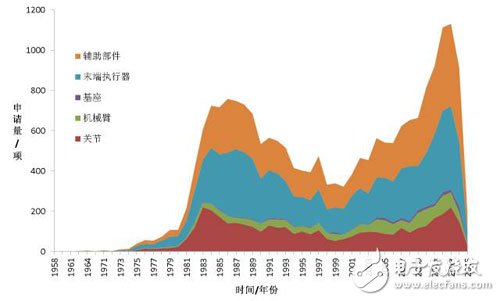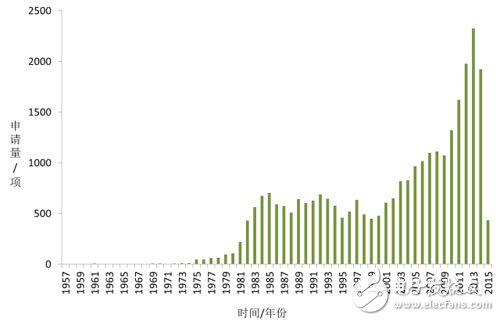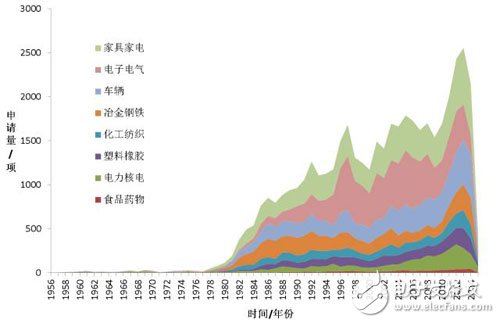With the advancement of industrial robot technology and the promotion of applications, the upstream components and midstream integration and manufacturing technologies of industrial robots will be further refined and deepened, and the application fields of industrial robots will continue to expand. For the development of China's industrial robot industry, the core components and patents are indispensable. Compulsory skills for the rise of domestic industrial robots: core parts and patents Recently, Xinchuang has released the "Global Industrial Robot Industry Patent Analysis Report". The report data shows that in the global industrial robot field, the number of patent applications in upstream parts and downstream applications is equivalent. Among them, patent applications related to control systems. The largest amount, the reducer accounted for the largest proportion of costs, but the number of related patent applications is not much. According to the report, although the industrial robot industry has entered a mature stage from a global perspective, with the increasing demand for the optimization and upgrading of the manufacturing industry structure in the era of “intelligent manufacturingâ€, the upstream components and midstream integration and manufacturing technologies of industrial robots will further Refining and deepening, the industrial robot technology will continue to expand to the downstream application areas. At the same time, as the technology-oriented cooperation, mergers and acquisitions and other transactions are increasingly frequent, the future will be more valuable through patent data analysis. reference. Upstream: patents in the core component field are monopolized by foreign companies During the burgeoning period of the industrial robot industry from 1954 to 1976, the number of patent applications grew slowly, and the number of patent applications for reducers, control hardware, control software, and drive systems was also very small (Figure 1). In the industrial robot industry development period and the perceived robot period from 1977 to 1990, with the transfer of the industrial robot industry to Japan, a large number of Japanese companies such as Fanuc, Yaskawa, Matsushita, Fujitsu, Nabtesco and Hamernaco were created. Leading enterprises in industrial robots have driven the rapid growth of patent applications for industrial robots. Obviously, it has also led to an increase in the number of patent applications for core components with a monopoly position in Japan. Perceived the complex control requirements of the robot, resulting in a sharp increase in the number of patent applications for control hardware and control software. Although the number of patent applications for reducers has been small and the growth has been stable, the related core technologies are absolutely monopolized by Nabtesco and Hamerna in Japan, and the two companies are bound with industrial robots. In cooperation, the reducer has always been the highest proportion of the total cost of industrial robots. Figure 1 Patent application status of upstream core components of industrial robots Up to now, the core component reducer, control hardware, control software and drive system are still the bottleneck restricting the development of China's industrial robot industry. With the transfer of the industrial robot industry to China in the mid-to-late 1990s, combined with China's national conditions and the strong demand for upgrading the industrial structure of the manufacturing industry, in order to break through these bottlenecks as soon as possible and enhance the competitiveness of Chinese industrial robots, China is on industrial robots. A large number of patent layouts have been carried out in the middle and lower reaches. The increase in the number of patent applications for industrial robots in China has led to a significant increase in the number of patent applications for industrial robots worldwide, and has also led to an increase in the number of patent applications for core components. From 1977 to 1990, the teaching robot was upgraded to a perceptual robot, and the emergence of sensing technology not only promoted the development of control hardware and control software, but also required performance requirements for end effectors such as robot grippers and sensors, robot joints and robot arms. It has also greatly improved, driving the explosive growth of patent applications for robot end-effectors, joints, and robotic arms (Figure 2). As the industrial robot industry entered maturity in the late 1990s, patent applications for components such as end-effectors, joints, and robotic arms slowed down, showing a downward trend. However, the second transfer of the industrial robot industry has also led to an increase in the number of patent applications in these areas. The reason is that the transfer of the industrial robot industry to China has inspired the Chinese applicants' great passion for innovation, because the core parts and components are foreign. The monopoly of the enterprise, the patents of Chinese applicants are mostly distributed in the field of non-core parts such as end actuators, joints and mechanical arms. Figure 2 Patent application status of other parts upstream of industrial robot Midstream: China's patent application for pulling integration and manufacturing continues to rise The patent application status of industrial robot midstream integration and manufacturing is completely consistent with the global industrial robot patent application status (Figure 3). The ultimate production goal of industrial robots is to apply to downstream production areas, so integration and manufacturing are important at every stage. During the burgeoning period of the industry, industrial robots developed slowly and related patent applications were very few. During the industrial development period, the patents related to industrial robot integration and manufacturing have grown dramatically. In the late 1990s, the industrial robot industry is in a mature stage, and the patent applications of foreign applicants tend to be stable. However, based on China's development into the world's largest industrial robot market, China's innovation passion is high, and more than 80% of China's industries Robotics companies are engaged in robot integration and manufacturing, and the related patent applications are also the most, which directly drives the continuous increase in the number of patent applications for industrial robot integration and manufacturing in the world. Figure 3 Industrial robot midstream integration and manufacturing patent application status Downstream: Industrial robot technology applications continue to expand With the advancement of technology, the application field of industrial robots is also rapidly expanding. Industrial robots can be said to be fruitful in various industries, and their applications in various fields are constantly rising (Figure 4). With the gradual deepening of the global industrial 4.0 transformation, the application field of industrial robots will further expand and the application volume will increase substantially. Experts inside and outside the industry believe that the future trend of industrial robots will be based on big data, and its more functions will be integrated into the "Internet +" element, which will be more security and sensitivity. Figure 4 Patent application status of various application fields downstream of industrial robots The automotive industry is the most widely used industrial robot, and is used in a large number of processes such as arc welding, spot welding, spraying, handling, gluing and stamping. In developed countries, automotive industry robots account for more than 53% of total robots. In China, 50% of industrial robots are used in the automotive industry, of which more than 50% are welding robots. China is in a period of rising auto ownership rate. The demand for industrial robots will show a rapid growth trend in the next few years. The application of industrial robots in China's auto industry will develop rapidly and greatly improve the efficiency and technology content of the auto industry. LifePO4 Battery,Lithium Battery,Lithium Battery Packs,Lithium Battery 48V 200Ah Easun Power Technology Corp Limited , https://www.easun-power.com



LifePO4 Batteries: The Future of Energy Storage
LifePO4 batteries stand at the forefront of today's energy solutions, offering a leap in battery technology compared to traditional types. Known for their robust performance, safety, and longevity, LifePO4 Battery technology is changing the way we power our world.
Whether it's bringing electric vehicles to life, fueling the shift towards renewable energy systems, or ensuring reliability in off-grid applications and heavy-duty industrial machinery, LifePO4 batteries are versatile powerhouses. Their high energy density, swift recharge rates, and impressive lifespan put them a step ahead in energy storage.
Safety is a hallmark of LifePO4 technology. With a natural resistance to common battery hazards like overheating and thermal runaway, LifePO4 batteries offer a dependable energy storage solution across a variety of industries.
Step into the future with LifePO4 batteries – where consistent performance, cycle after cycle, is not just promised; it's delivered. Embrace the cutting-edge of energy storage and elevate your application's capabilities with the efficiency and reliability of LifePO4.
Why Choose LifePO4 Batteries?
Exceptional Energy Density: Power more with less; LifePO4 batteries pack a significant energy punch.
Fast Charging: Get powered up quickly with LifePO4’s Lithium Battery rapid charging feature.
Longevity for the Long Haul: With an extended lifespan and superior cycle life, LifePO4 batteries offer enduring power.
Safety Comes First: Benefit from the outstanding safety performance of these batteries, minimizing risks in every application.
Versatility Unleashed: From Lithium Battery Packs for portable applications to Lithium Battery 48V 200Ah setups for expansive systems, LifePO4 batteries cater to a broad spectrum of needs.
Eco-friendly Energy: Make the green choice with LifePO4’s environmentally friendly profile.
Peak Performance: Experience high efficiency and unwavering performance, ensuring your systems run at their best.
Explore the revolutionary capabilities of LifePO4 batteries, and let's power a brighter, more sustainable future together.